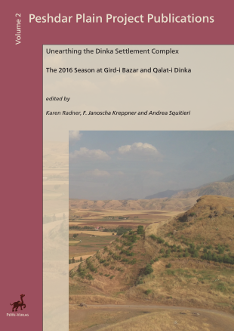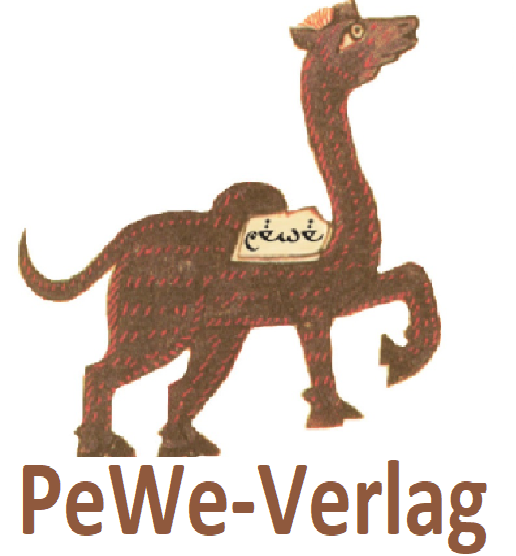
Karen Radner — F. Janoscha Kreppner — Andrea Squitieri (eds.)
Unearthing the Dinka Settlement Complex.
The 2016 Season at Gird-i Bazar and Qalat-i Dinka
Peshdar Plain Project Publications — Volume 2
Format: 30 x 21 cm — Hardcover
Umfang: 186 Seiten, mehr als 180 farbige Abbildungen
ISBN: 978-3-935012-28-7
Preis: 33,80 €
© PeWe-Verlag 2017
Mit Beiträgen von Mark Altaweel, Silvia Amicone, Andrei Ašandulesei, Christoph Berthold, Francesca Chelazzi, Vera Egbers, Jörg Fassbinder, Tina Greenfield, Zahra Hashemi, Jean-Jacques Herr, F. Janoscha Kreppner, Alessia Palmisano, Elsa Perruchini, Karen Radner, Melissa Rosenzweig, Marion Scheiblecker, Andrea Squitieri
Der Bericht über die Aktivitäten des Peshdar Plain Project im Jahr 2016 präsentiert neues Material zur Besiedelung und Nutzung der Bora-Ebene, gelegen am Oberlauf des Unteren Zab nahe der modernen Kreisstadt Qaladze, in der neuassyrischen und sassanidischen Perioden.
Das Buch bespricht im Detail die Ergebnisse der ersten Testgrabungen auf der Zitadelle von Qalat-i Dinka und der zweiten Ausgrabungskampagne im Wohnviertel von Gird-i Bazar, wo bisher eine zusammenhängende Fläche von 625 m2 ausgegraben werden konnte. Hier finden sich einerseits gut ausgestattete Häuser mit mehreren Räumen, die um Höfe mit Brunnen und Entwässerungskanälen gruppiert sind, andererseits eine offener Platz mit einem Töpferofen, dessen letzte Brennladung geborgen werden konnte.
Das Buch legt außerdem die Resultate der geophysikalischen Erforschung der Bora-Ebene vor, wo einerseits Magnetometerprospektion des gesamten neuassyrischen Siedlungsbereichs fortgesetzt wurde, der nun als Komplex von mindesten 60 Hektar erkannt wurde, und andererseits Elektrische Widerstandsmessungen (ERT) begonnen wurden, um das alte Qanat-Bewässerungssystem zu erforschen, das wohl für die neuassyrische Siedlung angelegt wurde.
Drei Kapitel sind der Keramik von Gird-i Bazar gewidmet und bieten eine erste Übersicht über die bisher belegten chaînes opératoires, eine überarbeiteten Klassifikation der Waren, die nun auch die Ergebnisse der petrographischen Dünnschliffanalyse miteinbezieht, und die ersten Resultate der chemischen Rückstandsanalysen, die für eine Auswahl von Gefäßen der neuassyrischen Siedlung durchgeführt wurden. Ein weiteres Kapitel stellt die Kleinfunde aus dieser Periode vor.
Ein bioarchäologisches Kapitel präsentiert die ersten Ergebnisse der Analysen der Tierknochen und der paläobotanischen Überreste der neuassyrischen Besiedelung und bespricht den jüngeren Friedhof von Gird-i Bazar, den die Resultate der Radiokarbonanalyse eines Zahnes nun sicher in die sassanidische Periode datiert.
With contributions of Mark Altaweel, Silvia Amicone, Andrei Ašandulesei, Christoph Berthold, Francesca Chelazzi, Vera Egbers, Jörg Fassbinder, Tina Greenfield, Zahra Hashemi, Jean-Jacques Herr, F. Janoscha Kreppner, Alessia Palmisano, Elsa Perruchini, Karen Radner, Melissa Rosenzweig, Marion Scheiblecker, Andrea Squitieri
This report of the 2016 activities of the Peshdar Plain Project presents new data for the occupation of the Bora Plain on the upper reaches of the Lesser Zab near the modern district centre of Qaladze in the Neo-Assyrian and Sassanian periods.
The book details the results of the first test excavations at the citadel of Qalat-i Dinka and of the on-going excavations at the settlement quarter of Gird-i Bazar. Here, a continuous excavated area of 625 m2 has been uncovered, occupied by several well-appointed multi-room houses with courtyards, wells and drainage systems and an open area around a pottery kiln, which was found complete with its last load.
The book also presents the results of the geophysical exploration of the Bora Plain: on the one hand, the continuation of the magnetometer survey of the entire Neo-Assyrian settlement, now recognised to be a complex of at least 60 hectares, and on the other hand, the new electrical resistivity tomography (ERT) investigations of the ancient qanat irrigation system that seems to be connected to the Neo-Assyrian settlement.
The three chapters on the pottery of Gird-i Bazar present a first overview of the attested chaînes opératoires, the updated fabric classification on the basis of thin section petrography analysis and the first results of the residue analysis performed on a selection of vessels. Another chapter is devoted to the small finds of the Neo-Assyrian occupation.
A chapter on the bioarchaeology of Gird-i Bazar presents preliminary results of the analysis of the animal bones and of the palaeobotanical remains from the Neo-Assyrian settlement and discusses the Sassanian-period graveyard, now dated by 14C analysis, on top of the ruins of the Neo-Assyrian occupation.
